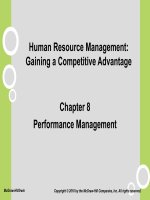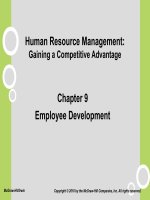HRM gaining a competitive advantage chapter 011 3rd ed
Bạn đang xem bản rút gọn của tài liệu. Xem và tải ngay bản đầy đủ của tài liệu tại đây (333.98 KB, 18 trang )
Part IV
Compensation of
Human Resources
Standard Slide Sample
Chapter 11
Pay Structure Decisions
Chapter 12
Recognizing Employee Contributions with Pay
Chapter 13
Employee Benefits
Irwin/McGraw-Hill
© The McGraw-Hill Companies,
11
Chapter
Irwin/McGraw-Hill
Pay Structure
Decisions
Objectives
• List the major decision areas and concepts in
employee compensation management.
• Describe the major administrative tools used to
manage employee compensation.
• Explain the importance of competitive labor-market
and product-market forces in compensation
decisions.
• Discuss the significance of process issues such as
communication in compensation management.
• Describe new developments in the design of pay
structure.
• Explain the reasons for the controversy over
executive pay.
• Describe the regulatory framework foe employee
compensation.
© The McGraw-Hill Companies,
11-2
Administrative
Tool
Focus of
Comparison
Consequence
Irwin/McGraw-Hill
Pay Structure and
Consequences
Pay Level
Job Structure
Market surveys
Job evaluation
External
Internal
- external moves:
attraction / retention
of employees
- labor costs
- employee attitudes
- internal moves:
promotion, transfer
- cooperation
among employees
- employee attitudes
© The McGraw-Hill Companies,
Equity Theory
11-3
Pay, benefits,
opportunities, etc.
OUTCOME
INPUTS
the same,
more or less
<=>
?
OUTCOME
INPUTS
effort, ability,
experience etc.
A person evaluates fairness by comparing their ratio with
others.
Irwin/McGraw-Hill
© The McGraw-Hill Companies,
Three Employee Views of the
Pay Decision
11-4
11
22
33
Pay LevelLevel- Same
Same job
job in
in Different
Different organizations
organizations
Pay
Pay Structure
Structure -- Different
Different jobs
jobs in
in Same
Same organization
organization
Pay
Individual Pay
Pay Differences
Differences -- Different
Different people
people in
in
Individual
Same job
job
Same
Irwin/McGraw-Hill
© The McGraw-Hill Companies,
11-5
Market Pressures in Developing
Pay Levels
Deciding What to Pay ?
Product-market competition
competition
Product-market
upper bound
bound on
on labor
labor cost
cost
upper
staffing level
level
staffing
average cost
cost per
per employee
employee
average
Labor-market competition
competition
Labor-market
lower bound
bound on
on pay
pay levels
levels
lower
Irwin/McGraw-Hill
© The McGraw-Hill Companies,
Market Pay Surveys - Benchmarking
11-6
Factors to consider
11
22
33
44
Identify key
key laborlabor- and
and product-market
product-market
Identify
competition
competition
Identify key
key jobs
jobs v.
v. non-key
non-key jobs
jobs
Identify
Weight and
and combine
combine pay
pay rates
rates appropriately
appropriately
Weight
Track appropriate
appropriate ratios
ratios over
over time
time
Track
revenues per
per employee
employee
revenues
revenues per
per labor
labor cost
cost
revenues
work force
force quality
quality (e.g.
(e.g. education
education levels)
levels)
work
Irwin/McGraw-Hill
© The McGraw-Hill Companies,
11-7
Example of a Three-Factor Job
Evaluation System
Compensable Factors
Total
Job Title
Complexity
Experience
Education
Points
Computer operator
40
30
40
110
Computer programmer
40
50
65
155
Systems analyst
65
60
85
210
Irwin/McGraw-Hill
© The McGraw-Hill Companies,
11-8
Approaches to Developing a Pay
Structure
Market survey
survey data
data
Market
external comparisons
comparisons
external
Pay policy
policy line
line
Pay
combines internal
internal &
& external
external
combines
Pay grade
grade
Pay
Irwin/McGraw-Hill
© The McGraw-Hill Companies,
Developing a Pay Policy Line
11-9
8
7
6
monthly
salary
5
($000)
4
PAY
3
2
Line of Best Fit :
using Market-Survey data
in Table 14.4
1
40
80
120
160
200
240
280
Job Evaluation Points
Irwin/McGraw-Hill
© The McGraw-Hill Companies,
32
Developing a Pay Policy Line
11-10
Predicted Salary = $7,128
8
7
6
monthly
salary
5
($000)
4
PAY
Predicted Salary = $6,486
3
2
1
Job Evaluation Points = 315
40
80
120
160
200
240
280
Job Evaluation Points
Irwin/McGraw-Hill
© The McGraw-Hill Companies,
32
Pay Grade Structure
11-11
8
7
6
monthly
salary
5
(000)
4
PAY
3
2
1
100
Irwin/McGraw-Hill
150
200
250
300
Job Evaluation Points
350
© The McGraw-Hill Companies,
Process Issues
11-12
Participation
Participation
Use task
task forces
forces for
for suggestions
suggestions
Use
Communication
Communication
Employees need
need to
to understand
understand
Employees
system
system
Need to
to keep
keep managers
managers aware
aware of
of
Need
changes
changes
Managers need
need to
to explain
explain system
system
Managers
changes
changes
Irwin/McGraw-Hill
© The McGraw-Hill Companies,
Current Challenges
11-13
Problems with
with Job
Job Based
Based Pay
Pay
Problems
Structure
Structure
too rigid,
rigid, reduces
reduces flexibility
flexibility
too
reinforces top-down
top-down
reinforces
retards changes
changes
retards
does not
not reward
reward behavior
behavior change
change
does
discourages lateral
lateral moves
moves
discourages
Irwin/McGraw-Hill
© The McGraw-Hill Companies,
New Approaches
11-14
Delayering and
and Banding
Banding
Delayering
Skill (knowledge)
(knowledge) -- based
based pay
pay
Skill
increases flexibility
flexibility
increases
firm needs
needs to
to use
use available
available skills
skills
firm
Irwin/McGraw-Hill
© The McGraw-Hill Companies,
Can the U.S. Labor Force Compete?
11-15
Labor costs
costs are
are unstable
unstable over
over time
time
Labor
Quality &
& productivity
productivity of
of labor
labor varies
varies
Quality
Non-labor cost
cost factors
factors also
also
Non-labor
important in
in locating
locating facilities
facilities
important
market proximity
proximity
market
response time
time
response
Irwin/McGraw-Hill
© The McGraw-Hill Companies,
11-16
Comparative Productivity and Unit Labor
Costs: Unites States, Germany, and Japan
Productivity (value added per labor hour)
100
100
$200
83
153
76
133
50
100
$100
Legend:
U.S.
Germany
Japan
Irwin/McGraw-Hill
© The McGraw-Hill Companies,
Chief Executive Officer Pay in
Selected Countries
11-17
Multiple of CEO to
Manufacturing Employee
Total Remuneration
30
24
20
16
11
10
United
States
Irwin/McGraw-Hill
France
9
Germany
Japan
© The McGraw-Hill Companies,









